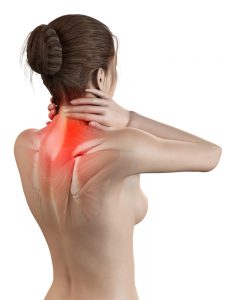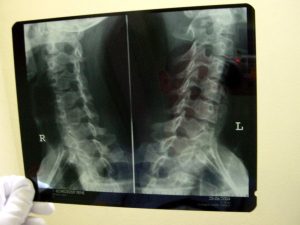‘Turtle posture’ most important cause of neck hernia
Cause, symptoms, diagnosis, treatment and exercises.
A ‘hernia’ is the collective name of 20 different conditions. In all cases, it is a bulge of a tissue or organ from the own bodily cavity. This is the reason that an umbilical hernia, inguinal hernia and diaphragmatic hernia are classified as hernias. One of the most common is a neck hernia or cervical radicular syndrome (CRS). The latter is being discussed in the current article.
What is a neck hernia?
The cervical spine consists seven vertebrae with intervertebral discs in between the vertebrae. Similar to a back hernia, a neck hernia is caused by a bulging of one of these flexible intervertebral discs. In most cases this occurs between the sixth and seventh vertebra. When this bulge starts to compress a nerve, pain sensations occur in arms, neck and shoulders.
What are the causes of a neck hernia?
In most of the cases, a neck hernia originates from a wrong posture. In particular, the ‘turtle posture’ causes a lot of problems: leaning forward with head and shoulders. Frequently and extensively taking a wrong posture causes the vertebrae in the neck to become skewed and a bulge can occur, but can also occur when the neck gets too little strain. When the muscles are weakened, the cervical spine gets too little support to stay in the proper position. Also, age plays an important roll, because the intervertebral discs dry out, the skewed position and the chance of bulging may further increase. An acute neck hernia may occur involving a traffic or sporting accident. Moreover, smoking may accelerate the wear process of the intervertebral discs.
What are the symptoms of a neck hernia?
The symptoms of a neck hernia are different from that of a back hernia. The nerve roots from the back branch into the legs causing local symptoms. The nerve roots in the neck however branch into the shoulders, arms and hands. Therefore, pain is felt in these areas consisting of radiating pain to both arms and pain in the neck and shoulder area. In addition, loss of strength, numbness or a tingling sensation may occur in the arms. In case of a severe neck hernia, paralysis symptoms may even occur.
How is neck hernia diagnosed?
Upon continuing pain in the arms (and possibly also neck) an appointment with the doctor will be made. When the suspicion exists that a neck hernia is involved, referral to a neurologist is indicated. Further physical examination will then be performed to establish whether the pain in the arms and the putative outbreaks are indeed caused by a bulging intervertebral disc in the neck. Moreover, an MRI-scan will be made which in most of the cases enables a proper diagnosis.
How is a neck hernia treated?
In the case of a neck hernia, surgery is not always necessary. In about 85% of the cases the symptoms will spontaneously disappear possibly supported by physiotherapy, proper resting and painkillers. Therefore, they will wait eight weeks before performing surgery. If surgery is needed, this will be performed by a neurosurgeon. A strong indication for surgery is present when severe and acute nerve failure occurs. This is however not very frequent. Upon a relative surgery indication, the patient itself indicates that the persisting pain is unbearable and proper functioning is limited.
How is surgery in case of a neck hernia performed?
In case of a neck hernia, surgery can be performed via the neck or the throat and will be performed under full anesthesia. Upon surgery via the neck, the vertebral arches are partially or completely removed and thickened connective tissue and bone proliferation excised. This way, the nerve roots are running freely again making the symptoms to disappear. Upon surgery via the throat, the affected intervertebral disc is totally removed including the bulge that caused compression of the nerves. In most cases, surgery can then be finished. It is sometimes also necessary to fixate the cervical spine (arthrodesis) by inserting a metal or plastic ‘cage’ between the adjacent vertebrae. It is also possible to replace the affected disc by a plastic one.
Neck collar most effective treatment in neck hernia
Wearing a neck collar is the most effective treatment in the treatment of a recently acquired neck hernia. This was shown in a study by the Amsterdam Medical Center (AMC). Researchers studied the effect of three non-surgical treatment methods in people with a recently acquired neck hernia. Two-hundred patients were divided into three groups. The first group got a semi-hard neck collar and had to take as much rest as possible for 3-6 weeks. The second group received a daily exercise program under guidance of a physical therapist. The third group was asked to continue their daily activities as much as possible. In case of the first two methods, the pain decreased faster compared to the third method. The best results were present in the groups that wore the neck collar. After six months, there were differences between the 200 patients and had no or little pain anymore.
Exercises that can relieve symptoms from a neck hernia
With a neck hernia, it is important to keep moving because otherwise the neck will become stiff and the muscles will lose strength. As a result, the symptoms and therefore the pain will increase. Together with a physiotherapist, exercises will be performed to improve the flexibility of the neck and muscle strength. Below some simple exercises that can be performed at home. However, do not exceed the pain threshold.
Exercise 1:
Sit up straight in a chair. Turn the head very carefully to the right shoulder. Keep this position for five seconds. Repeat the exercise with the other shoulder.
Exercise 2:
Sit up straight in a chair. Tilt the head forward (downward) to the chest. Keep this position for five seconds. Slowly move the head upwards again.
Exercise 3:
Sit up straight in a chair. Breathe out and move your head to the ceiling. Keep this position for five seconds. Slowly move the head back again.
Exercise 4:
Sit up straight in a chair. Breathe in deeply. Breathe out and first turn your head to the left and then to the right

Share this page
Tweet

Download for free the booklet ‘Moving without pain’ with a retail value of $6.75 / £4.95.
Any questions? Please feel free to contact us. Contact us.








